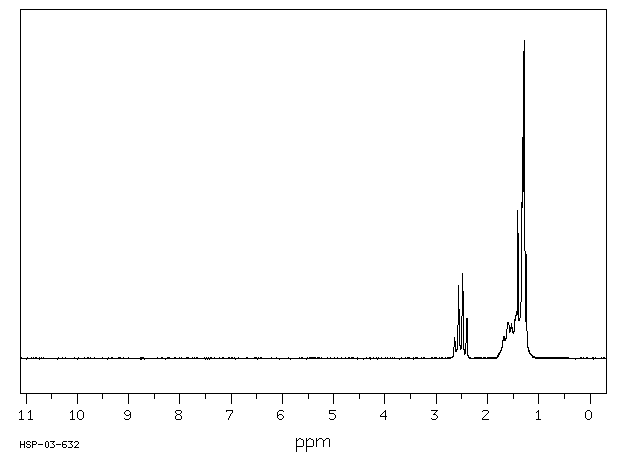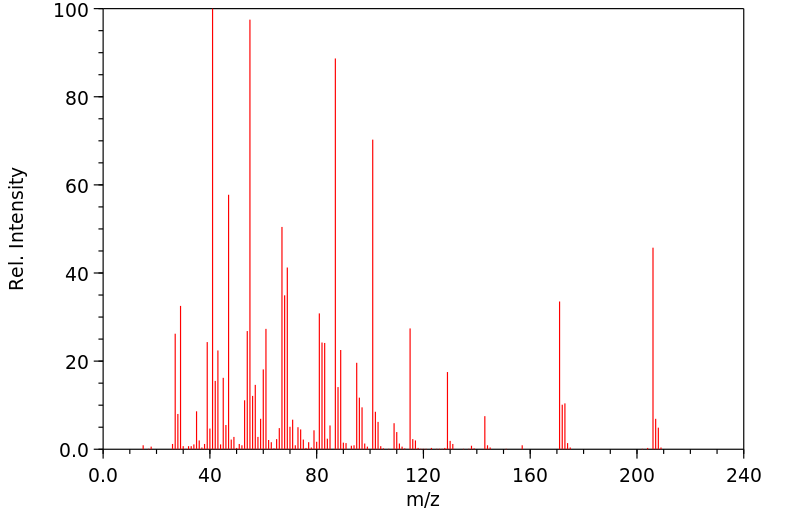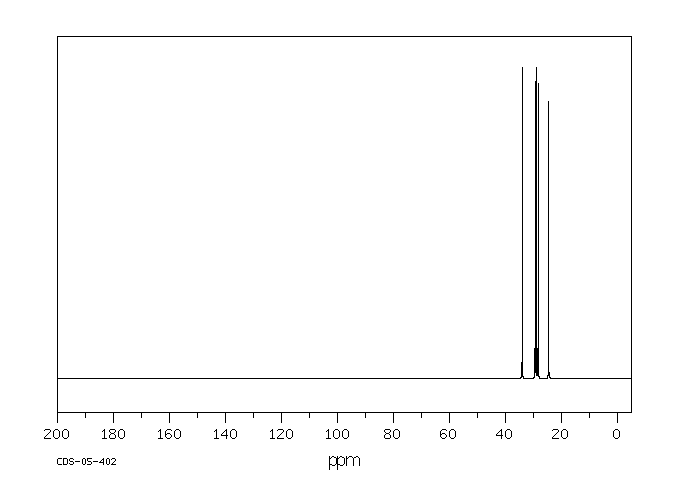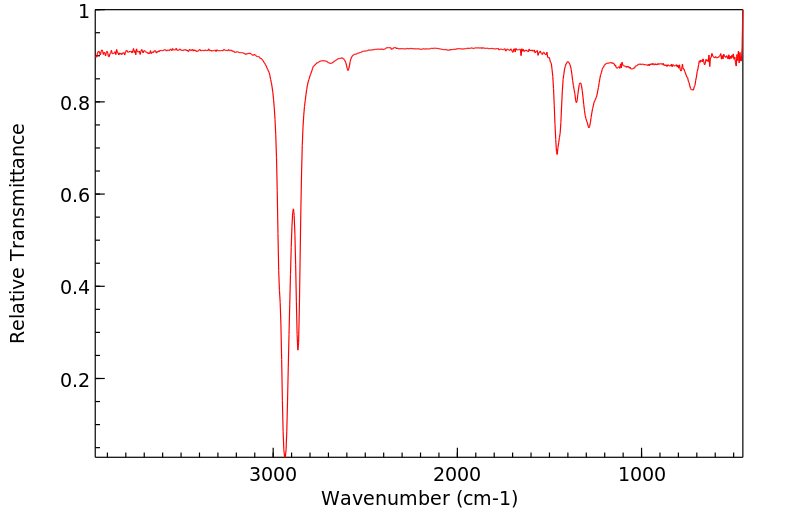1,10-癸二硫醇 | 1191-67-9
中文名称
1,10-癸二硫醇
中文别名
1,10-十二烷基二硫醇;1,1-癸二硫醇
英文名称
decane-1,10-dithiol
英文别名
1,10-decanedithiol
CAS
1191-67-9
化学式
C10H22S2
mdl
MFCD00022095
分子量
206.417
InChiKey
UOQACRNTVQWTFF-UHFFFAOYSA-N
BEILSTEIN
——
EINECS
——
-
物化性质
-
计算性质
-
ADMET
-
安全信息
-
SDS
-
制备方法与用途
-
上下游信息
-
文献信息
-
表征谱图
-
同类化合物
-
相关功能分类
-
相关结构分类
物化性质
-
熔点:17°C
-
沸点:171-172°C 0,5mm
-
密度:0,95 g/cm3
-
闪点:171-172°C/0.5mm
-
稳定性/保质期:
如果按照规格使用和储存,不会发生分解,没有已知危险反应。应避免与氧化物接触。
计算性质
-
辛醇/水分配系数(LogP):4.4
-
重原子数:12
-
可旋转键数:9
-
环数:0.0
-
sp3杂化的碳原子比例:1.0
-
拓扑面积:2
-
氢给体数:2
-
氢受体数:2
安全信息
-
危险等级:9
-
安全说明:S26,S36/37/39
-
危险类别码:R22,R36/38
-
危险品运输编号:UN3334
-
RTECS号:HD8455000
-
海关编码:2930909090
-
危险类别:9
-
包装等级:III
-
危险性防范说明:P501,P273,P264,P280,P302+P352,P337+P313,P305+P351+P338,P362+P364,P332+P313
-
危险性描述:H315,H319,H413,H372
-
储存条件:请将贮藏器保持密封,并存放在阴凉、干燥的地方。同时,确保工作环境中具有良好通风或排气设施。
SDS
1,10-癸二硫醇 修改号码:6
模块 1. 化学品
产品名称: 1,10-Decanedithiol
修改号码: 6
模块 2. 危险性概述
GHS分类
物理性危害 未分类
健康危害
皮肤腐蚀/刺激 第2级
严重损伤/刺激眼睛 2A类
环境危害 未分类
GHS标签元素
图标或危害标志
信号词 警告
危险描述 造成皮肤刺激
造成严重眼刺激
防范说明
[预防] 处理后要彻底清洗双手。
穿戴防护手套/护目镜/防护面具。
[急救措施] 眼睛接触:用水小心清洗几分钟。如果方便,易操作,摘除隐形眼镜。继续冲洗。
眼睛接触:求医/就诊
皮肤接触:用大量肥皂和水轻轻洗。
若皮肤刺激:求医/就诊。
脱掉被污染的衣物,清洗后方可重新使用。
模块 3. 成分/组成信息
单一物质/混和物 单一物质
化学名(中文名): 1,10-癸二硫醇
百分比: >98.0%(GC)(T)
CAS编码: 1191-67-9
俗名: 1,10-Dimercaptodecane
1,10-癸二硫醇 修改号码:6
模块 3. 成分/组成信息
分子式: C10H22S2
模块 4. 急救措施
吸入: 将受害者移到新鲜空气处,保持呼吸通畅,休息。若感不适请求医/就诊。
皮肤接触: 立即去除/脱掉所有被污染的衣物。用大量肥皂和水轻轻洗。
若皮肤刺激或发生皮疹:求医/就诊。
眼睛接触: 用水小心清洗几分钟。如果方便,易操作,摘除隐形眼镜。继续清洗。
如果眼睛刺激:求医/就诊。
食入: 若感不适,求医/就诊。漱口。
紧急救助者的防护: 救援者需要穿戴个人防护用品,比如橡胶手套和气密性护目镜。
模块 5. 消防措施
合适的灭火剂: 干粉,泡沫,二氧化碳
不适用的灭火剂: 水(有可能扩大灾情。)
特殊危险性: 小心,燃烧或高温下可能分解产生毒烟。
特定方法: 从上风处灭火,根据周围环境选择合适的灭火方法。
非相关人员应该撤离至安全地方。
周围一旦着火:如果安全,移去可移动容器。
消防员的特殊防护用具: 灭火时,一定要穿戴个人防护用品。
模块 6. 泄漏应急处理
个人防护措施,防护用具, 使用个人防护用品。远离溢出物/泄露处并处在上风处。确保足够通风。
紧急措施: 泄露区应该用安全带等圈起来,控制非相关人员进入。
环保措施: 防止进入下水道。
控制和清洗的方法和材料: 用合适的吸收剂(如:旧布,干砂,土,锯屑)吸收泄漏物。一旦大量泄漏,筑堤控
制。附着物或收集物应该立即根据合适的法律法规废弃处置。
模块 7. 操作处置与储存
处理
技术措施: 在通风良好处进行处理。穿戴合适的防护用具。防止烟雾产生。处理后彻底清洗双手
和脸。
注意事项: 如果蒸气或浮质产生,使用通风、局部排气。
操作处置注意事项: 避免接触皮肤、眼睛和衣物。
贮存
储存条件: 保持容器密闭。存放于凉爽、阴暗处。
远离不相容的材料比如氧化剂存放。
包装材料: 依据法律。
模块 8. 接触控制和个体防护
工程控制: 尽可能安装封闭体系或局部排风系统,操作人员切勿直接接触。同时安装淋浴器和洗
眼器。
个人防护用品
呼吸系统防护: 防毒面具。依据当地和政府法规。
手部防护: 防护手套。
眼睛防护: 安全防护镜。如果情况需要,佩戴面具。
皮肤和身体防护: 防护服。如果情况需要,穿戴防护靴。
模块 9. 理化特性
外形(20°C): 液体
1,10-癸二硫醇 修改号码:6
模块 9. 理化特性
外观: 透明
颜色: 无色-微浅黄色
气味: 无资料
pH: 无数据资料
熔点: 17°C (凝固点)
沸点/沸程 297 °C
闪点: 无资料
爆炸特性
爆炸下限: 无资料
爆炸上限: 无资料
密度: 0.95
溶解度:
[水] 无资料
[其他溶剂] 无资料
模块 10. 稳定性和反应性
化学稳定性: 一般情况下稳定。
危险反应的可能性: 未报道特殊反应性。
须避免接触的物质 氧化剂
危险的分解产物: 一氧化碳, 二氧化碳, 硫氧化物
模块 11. 毒理学信息
急性毒性: orl-mus LDLo:1600 mg/kg
对皮肤腐蚀或刺激: 无资料
对眼睛严重损害或刺激: 无资料
生殖细胞变异原性: 无资料
致癌性:
IARC = 无资料
NTP = 无资料
生殖毒性: 无资料
RTECS 号码: HD8455000
模块 12. 生态学信息
生态毒性:
鱼类: 无资料
甲壳类: 无资料
藻类: 无资料
残留性 / 降解性: 无资料
潜在生物累积 (BCF): 无资料
土壤中移动性
log水分配系数: 无资料
土壤吸收系数 (Koc): 无资料
亨利定律 无资料
constaNT(PaM3/mol):
模块 13. 废弃处置
如果可能,回收处理。请咨询当地管理部门。建议在装有后燃和洗涤装置的化学焚烧炉中焚烧。废弃处置时请遵守
国家、地区和当地的所有法规。
1,10-癸二硫醇 修改号码:6
模块 14. 运输信息
联合国分类: 与联合国分类标准不一致
UN编号: 未列明
模块 15. 法规信息
《危险化学品安全管理条例》(2002年1月26日国务院发布,2011年2月16日修订): 针对危险化学品的安全使用、
生产、储存、运输、装卸等方面均作了相应的规定。
模块16 - 其他信息
N/A
模块 1. 化学品
产品名称: 1,10-Decanedithiol
修改号码: 6
模块 2. 危险性概述
GHS分类
物理性危害 未分类
健康危害
皮肤腐蚀/刺激 第2级
严重损伤/刺激眼睛 2A类
环境危害 未分类
GHS标签元素
图标或危害标志
信号词 警告
危险描述 造成皮肤刺激
造成严重眼刺激
防范说明
[预防] 处理后要彻底清洗双手。
穿戴防护手套/护目镜/防护面具。
[急救措施] 眼睛接触:用水小心清洗几分钟。如果方便,易操作,摘除隐形眼镜。继续冲洗。
眼睛接触:求医/就诊
皮肤接触:用大量肥皂和水轻轻洗。
若皮肤刺激:求医/就诊。
脱掉被污染的衣物,清洗后方可重新使用。
模块 3. 成分/组成信息
单一物质/混和物 单一物质
化学名(中文名): 1,10-癸二硫醇
百分比: >98.0%(GC)(T)
CAS编码: 1191-67-9
俗名: 1,10-Dimercaptodecane
1,10-癸二硫醇 修改号码:6
模块 3. 成分/组成信息
分子式: C10H22S2
模块 4. 急救措施
吸入: 将受害者移到新鲜空气处,保持呼吸通畅,休息。若感不适请求医/就诊。
皮肤接触: 立即去除/脱掉所有被污染的衣物。用大量肥皂和水轻轻洗。
若皮肤刺激或发生皮疹:求医/就诊。
眼睛接触: 用水小心清洗几分钟。如果方便,易操作,摘除隐形眼镜。继续清洗。
如果眼睛刺激:求医/就诊。
食入: 若感不适,求医/就诊。漱口。
紧急救助者的防护: 救援者需要穿戴个人防护用品,比如橡胶手套和气密性护目镜。
模块 5. 消防措施
合适的灭火剂: 干粉,泡沫,二氧化碳
不适用的灭火剂: 水(有可能扩大灾情。)
特殊危险性: 小心,燃烧或高温下可能分解产生毒烟。
特定方法: 从上风处灭火,根据周围环境选择合适的灭火方法。
非相关人员应该撤离至安全地方。
周围一旦着火:如果安全,移去可移动容器。
消防员的特殊防护用具: 灭火时,一定要穿戴个人防护用品。
模块 6. 泄漏应急处理
个人防护措施,防护用具, 使用个人防护用品。远离溢出物/泄露处并处在上风处。确保足够通风。
紧急措施: 泄露区应该用安全带等圈起来,控制非相关人员进入。
环保措施: 防止进入下水道。
控制和清洗的方法和材料: 用合适的吸收剂(如:旧布,干砂,土,锯屑)吸收泄漏物。一旦大量泄漏,筑堤控
制。附着物或收集物应该立即根据合适的法律法规废弃处置。
模块 7. 操作处置与储存
处理
技术措施: 在通风良好处进行处理。穿戴合适的防护用具。防止烟雾产生。处理后彻底清洗双手
和脸。
注意事项: 如果蒸气或浮质产生,使用通风、局部排气。
操作处置注意事项: 避免接触皮肤、眼睛和衣物。
贮存
储存条件: 保持容器密闭。存放于凉爽、阴暗处。
远离不相容的材料比如氧化剂存放。
包装材料: 依据法律。
模块 8. 接触控制和个体防护
工程控制: 尽可能安装封闭体系或局部排风系统,操作人员切勿直接接触。同时安装淋浴器和洗
眼器。
个人防护用品
呼吸系统防护: 防毒面具。依据当地和政府法规。
手部防护: 防护手套。
眼睛防护: 安全防护镜。如果情况需要,佩戴面具。
皮肤和身体防护: 防护服。如果情况需要,穿戴防护靴。
模块 9. 理化特性
外形(20°C): 液体
1,10-癸二硫醇 修改号码:6
模块 9. 理化特性
外观: 透明
颜色: 无色-微浅黄色
气味: 无资料
pH: 无数据资料
熔点: 17°C (凝固点)
沸点/沸程 297 °C
闪点: 无资料
爆炸特性
爆炸下限: 无资料
爆炸上限: 无资料
密度: 0.95
溶解度:
[水] 无资料
[其他溶剂] 无资料
模块 10. 稳定性和反应性
化学稳定性: 一般情况下稳定。
危险反应的可能性: 未报道特殊反应性。
须避免接触的物质 氧化剂
危险的分解产物: 一氧化碳, 二氧化碳, 硫氧化物
模块 11. 毒理学信息
急性毒性: orl-mus LDLo:1600 mg/kg
对皮肤腐蚀或刺激: 无资料
对眼睛严重损害或刺激: 无资料
生殖细胞变异原性: 无资料
致癌性:
IARC = 无资料
NTP = 无资料
生殖毒性: 无资料
RTECS 号码: HD8455000
模块 12. 生态学信息
生态毒性:
鱼类: 无资料
甲壳类: 无资料
藻类: 无资料
残留性 / 降解性: 无资料
潜在生物累积 (BCF): 无资料
土壤中移动性
log水分配系数: 无资料
土壤吸收系数 (Koc): 无资料
亨利定律 无资料
constaNT(PaM3/mol):
模块 13. 废弃处置
如果可能,回收处理。请咨询当地管理部门。建议在装有后燃和洗涤装置的化学焚烧炉中焚烧。废弃处置时请遵守
国家、地区和当地的所有法规。
1,10-癸二硫醇 修改号码:6
模块 14. 运输信息
联合国分类: 与联合国分类标准不一致
UN编号: 未列明
模块 15. 法规信息
《危险化学品安全管理条例》(2002年1月26日国务院发布,2011年2月16日修订): 针对危险化学品的安全使用、
生产、储存、运输、装卸等方面均作了相应的规定。
模块16 - 其他信息
N/A
制备方法与用途
Decane-1,1,10-dithiol is an important raw material and intermediate used in organic synthesis, pharmaceuticals, and agrochemicals.
反应信息
-
作为反应物:参考文献:名称:一种多功能橡胶助剂及其制备工艺摘要:本发明提供了一种多功能橡胶助剂,1,X‑二(N,N‑二邻苯二甲酰亚胺二硫)直链烷烃;同时,本发明还提供了1,X‑二(N,N‑二邻苯二甲酰亚胺二硫)直链烷烃的制备工艺,本发明的有益效果:①、合成工艺简洁易于操作;②产品分子中含有次磺酰胺类(N‑S型)和亚甲基链段两种结构,即具有防止胶料早期硫化焦烧的功能,亚甲基链段插入到橡胶分子结构中使得胶料有较好的柔韧性,起到抗硫化返原的作用;③本发明的制备工艺收率高、产品纯度高、无味且不喷霜;④本发明制备的新型多功能橡胶助剂产品能满足和顺应了今后发展低气味或无味轮胎的方向和要求,具有很好经济和社会效益,市场前景广阔。公开号:CN108689912A
-
作为产物:参考文献:名称:新型的含氮-硫供体混合的双核铂(II)配合物摘要:合成了一系列新颖的双核铂(II)配合物,其中包含氮-硫供体双齿混合螯合物系统,其中两个铂中心通过可变长度的脂族链连接。选择二齿螯合配体以使配合物稳定以免分解。四种合成的配合物[Pt 2(S 1,S 4-双(2-吡啶基甲基)-1,4-丁烷二硫醚)(OH 2)4 ] 4+(4NSpy)的p K a值和反应性, [Pt 2(S 1,S 6-双(2-吡啶基甲基)-1,6-己二硫醚)(OH 2)4 ] 4+(6NSpy),[Pt 2(S 1,S 8-双(2-吡啶基甲基)-1,8-辛二硫醚)( OH 2)4 ] 4+(8NSpy)和[Pt 2(S 1,S 10-双(2-吡啶基甲基)-1,10-癸二硫醚)(OH 2)4 ] 4+(10NSpy),进行了调查。该系统具有特殊的意义,因为对双核铂络合物的取代行为知之甚少,双核铂络合物含有形成脂族桥联配体一部分的双齿螯合物。此外,根据配体以及双核复合物的细胞毒DOI:10.1021/ic2018902
文献信息
-
Preparation of S-glycoside surfactants and cysteine thioglycosides using minimally competent Lewis acid catalysis作者:Lajos Z. Szabó、Dillon J. Hanrahan、Evan M. Jones、Erin Martin、Jeanne E. Pemberton、Robin PoltDOI:10.1016/j.carres.2015.12.008日期:2016.3Here we report a method for the preparation of anomerically pure beta-S-glycopyranosides (1,2-trans-glycosides) from the corresponding peracetate donors. S-glycosylation was performed in CHCl3 at reflux in the presence of a catalytic amount of InBr3. Deacylation of the intermediate peracetates were achieved under Zemplen conditions. Five pyranose examples, monosaccharides D-glucose and D-galactose
-
[EN] COSMETIC PROCESS FOR ATTENUATING WRINKLES<br/>[FR] PROCÉDÉ COSMÉTIQUE POUR ATTÉNUER LES RIDES申请人:OREAL公开号:WO2016050788A1公开(公告)日:2016-04-07The invention relates to a cosmetic process for wrinkled skin, comprising either the topical application to the skin of an extemporaneous mixture of a cosmetic composition comprising a polysaccharide polymer grafted with (meth)acrylate groups and of a crosslinking thiol compound having one or more thiol groups; or the sequential application to the skin of a cosmetic composition comprising a polysaccharide polymer grafted with (meth)acrylate groups, followed by the application of a crosslinking thiol compound having one or more thiol groups, or of a cosmetic composition containing same. The invention also relates to the use of the mixture of said grafted polysaccharide polymer and of said crosslinking thiol as a skin tensioning agent. The invention also relates to a cosmetic composition obtained by mixing a cosmetic composition comprising said grafted polysaccharide polymer and said crosslinking thiol. The invention relates to a kit comprising a first cosmetic composition comprising said grafted polysaccharide polymer and a second composition comprising said crosslinking thiol, the first and second compositions each been packaged in a distinct packaging assembly.该发明涉及一种用于皱纹皮肤的化妆过程,包括以下两种方式:要么将一种化妆组合物涂抹在皮肤上,该组合物包括一种聚糖聚合物,其与(甲基)丙烯酸酯基团进行嫁接,以及一种具有一个或多个硫醇基团的交联硫醇化合物的现场混合物;要么将一种包括聚糖聚合物,其与(甲基)丙烯酸酯基团进行嫁接的化妆组合物顺序涂抹在皮肤上,然后涂抹一种具有一个或多个硫醇基团的交联硫醇化合物,或者含有该化合物的化妆组合物。该发明还涉及将所述嫁接聚糖聚合物和所述交联硫醇的混合物用作皮肤紧致剂。该发明还涉及通过混合包括所述嫁接聚糖聚合物和所述交联硫醇的化妆组合物而获得的化妆组合物。该发明涉及一种套装,包括第一化妆组合物,其中包括所述嫁接聚糖聚合物,以及第二组成物,其中包括所述交联硫醇,第一和第二组成物分别被包装在不同的包装组件中。
-
Metal-free glycosylation with glycosyl fluorides in liquid SO<sub>2</sub>作者:Krista Gulbe、Jevgeņija Lugiņina、Edijs Jansons、Artis Kinens、Māris TurksDOI:10.3762/bjoc.17.78日期:——to covalently bind Lewis basic fluoride ions in a relatively stable fluorosulfite anion (FSO2−). Herein we report the application of liquid SO2 as a promoting solvent for glycosylation with glycosyl fluorides without any external additive. By using various temperature regimes, the method is applied for both armed and disarmed glucose and mannose-derived glycosyl fluorides in moderate to excellent yields液态SO 2是一种极性溶剂,可溶解共价和离子化合物。二氧化硫也具有路易斯酸性质,包括在一个相对稳定的fluorosulfite阴离子的能力共价结合路易斯碱性氟化物离子(FSO 2 - )。在本文中,我们报道了液态SO 2作为促进剂用于糖基氟化物的糖基化而没有任何外部添加剂的应用。通过使用各种温度方案,该方法可用于中等和极高产率的武装和解除武装的葡萄糖和甘露糖衍生的糖基氟化物。一系列新戊酰基保护的O-和S-甘露糖苷,以及C的一个实例合成甘露糖苷以证明糖基受体的范围。通过19 F NMR光谱证实了在液体SO 2中与糖基氟糖基化的过程中,亚硫酸氢盐物质的形成。提出了通过溶剂分离的离子对进行的二氧化硫辅助的糖基化机制,而观察到的α,β-选择性是受底物控制的,并且取决于热力学平衡。
-
CdSe quantum dot-encapsulated molecularly imprinted mesoporous silica particles for fluorescent sensing of bisphenol A作者:Youngdo Kim、Jae Bum Jeon、Ji Young ChangDOI:10.1039/c2jm34798a日期:——We prepared a highly sensitive molecularly imprinted fluorescent sensor by using a CdSe quantum dot (QD) as a signal transducer and a mesoporous silica nanoparticle as an imprinting material. Bisphenol-A (BPA) was chosen as a model template, which is known as an endocrine disruptor. Binding sites were selectively formed between the pores and CdSe QDs were encapsulated in the pores of the mesoporous silica. QD-encapsulated, molecularly imprinted mesoporous silica (QD-MIMS) particles exhibited excellent molecular recognition properties in terms of both sensitivity and selectivity. Owing to the proximity of the binding sites to the QDs, a significant, concentration-sensitive fluorescence quenching was observed in the presence of BPA. QD-MIMS showed a linear Stern–Volmer relationship for BPA and its analogs. QD-MIMS had a much larger quenching constant for BPA (by more than ten times) than for BPA analogs, demonstrating the high selectivity of QD-MIMS.我们通过使用CdSe量子点(QD)作为信号转换器和介孔二氧化硅纳米粒子作为印迹材料,制备了一种高灵敏度的分子印迹荧光传感器。选择双酚A(BPA)作为模型模板,这是一种已知的内分泌干扰物。在介孔与CdSe QD之间选择性地形成了结合位点,并且CdSe QD被封装在介孔二氧化硅的孔隙中。QD封装的分子印迹介孔二氧化硅(QD-MIMS)颗粒在灵敏度和选择性方面表现出了优异的分子识别性能。由于结合位点与QD的接近,在存在BPA的情况下观察到了显著的、浓度敏感的荧光淬灭。QD-MIMS对BPA及其类似物表现出线性的Stern-Volmer关系。QD-MIMS对BPA的淬灭常数远大于BPA类似物(超过十倍),这证明了QD-MIMS的高选择性。
-
Palladium-Catalyzed Linear Hydrothiocarbonylation of Unactivated Terminal Alkenes: Synthesis of Aliphatic Thioesters作者:Wangzhi Yu、Jian Han、Dongmei Fang、Min Wang、Jian LiaoDOI:10.1021/acs.orglett.1c00406日期:2021.4.2A Pd-catalyzed hydrothiocarbonylation of unactivated terminal alkenes is presented. According to this protocol, aliphatic thioesters were synthesized with exclusive linear selectivity under mild reaction conditions. Good to excellent yields (up to 91% yield), broad substrate scope, broad functional group tolerance, and utility of the method demonstrated the advantages of this protocol.
表征谱图
-
氢谱1HNMR
-
质谱MS
-
碳谱13CNMR
-
红外IR
-
拉曼Raman
-
峰位数据
-
峰位匹配
-
表征信息
同类化合物
铜,丙烷-2-硫醇
铅,丙烷-1-硫醇
苏-(2R,4R)-戊二硫醇
羟基-乙醛
硫甘油
癸烷-2-硫醇
甲硫醇铅
甲硫醇钠
甲硫醇-d4
甲硫醇-S-d
甲硫醇
甲三硫醇
环辛硫醇
环戊硫醇
环戊基甲硫醇
环庚烷-1,1-二硫醇
环己硫醇
环己烷-1,1-二硫醇
环己基甲硫醇
环十二烷硫醇
环丙硫醇
环丙基甲硫醇
环丁硫醇
油烯基硫醇
氟甲硫醇
氘代甲硫醇-D3
正十四烷基硫醇
末端脱氧核苷酸转移酶
戊赤藓四硫醇
戊烷-3-硫醇
异戊硫醇
异戊烯基硫醇
异丙硫醇
异丁硫醇
庚-3-烯-4-硫醇
己-2-烯-1-硫醇
巯基甲烷-13C
巯基乙醛
巯基乙胺氢溴酸盐
巯基乙胺
巯基-十一胺盐酸盐
壬烷-2-硫醇
吡啶,2-(戊基硫代)-,1-氧化
叔壬基硫醇
叔十六硫醇
叔十二烷硫醇
叔丁基硫醇
反式-2-丁烯-1-硫醇
双(巯基环戊烷)四氯化钛
半胱胺盐酸盐










